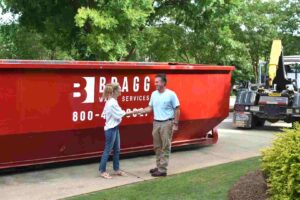Welcome to the ultimate resource for homeowners seeking mastery in yard waste removal and lawn care – a comprehensive guide that transcends the seasons. This guide is designed to empower you with essential knowledge and practical insights to transform your outdoor space into a thriving haven. From understanding the diverse classifications of yard waste to implementing eco-friendly disposal methods and seasonal lawn care strategies, this guide covers every facet. Whether you’re a novice looking to start your lawn care journey or a seasoned enthusiast aiming for a greener, more vibrant yard, the following pages are your roadmap to cultivating and maintaining a lush, healthy, and visually appealing lawn. Embark on a journey that delves into the nuances of proper tool selection, efficient waste removal techniques, and the art of composting to nurture nutrient-rich soil. Uncover the secrets of responsible disposal practices, integrating landscaping principles for both aesthetics and functionality. Discover DIY tips for a hands-on approach to lawn care and the significance of adhering to local regulations. Throughout this guide, we emphasize eco-friendly alternatives, fostering a harmonious relationship between a beautifully manicured lawn and sustainable environmental practices. Whether you’re a gardening novice or a seasoned green thumb, this comprehensive guide is your key to cultivating a picturesque, resilient, and eco-conscious outdoor sanctuary.
The Ultimate Guide to Yard Waste Removal and Lawn Care: A Comprehensive Handbook for a Thriving Outdoor Oasis
Welcome to A&B Junk’s definitive guide on Yard Waste Removal and Lawn Care, your go-to resource for transforming outdoor spaces into lush paradises. Explore expert insights and tips to revitalize your landscape sustainably.
Understanding Yard Waste: Types and Classification
Yard waste removal services encompasses a variety of materials, and understanding their types and classification is crucial for effective removal and disposal. Common yard waste includes grass clippings, leaves, branches, and other organic debris. Categorizing these materials helps homeowners plan their removal strategies. For instance, grass clippings and leaves can be composted, while larger branches may require a different disposal approach. This section will delve into the specifics of different yard waste types, offering insights into their decomposition rates and how they contribute to a sustainable lawn care routine.
Essential Tools and Equipment for Efficient Yard Waste Removal
Proper tools and equipment are essential for efficient yard waste removal. This section will provide an exhaustive list of tools needed for various tasks, from basic rakes and leaf blowers to more specialized equipment like wood chippers for branches. Guidance on choosing the right tools based on the size of the yard and the types of waste present will be included. Additionally, tips on maintenance and safety protocols will be discussed to ensure users can effectively and safely utilize these tools. A well-equipped homeowner can significantly streamline the yard waste removal process, saving time and effort while maintaining a clean and healthy lawn.
Seasonal Strategies for Lawn Care: Spring, Summer, Fall, and Winter
Each season brings unique challenges and opportunities for lawn care. This section will provide a comprehensive guide on seasonal strategies, detailing tasks such as fertilization, aeration, and weed control for each time of the year. Readers will learn how to adapt their yard maintenance routines to promote optimal growth and health depending on the current season. Understanding the seasonal nuances of lawn care is crucial for achieving a lush, resilient lawn throughout the entire year.
Composting 101: Turning Yard Waste into Nutrient-Rich Soil
Composting is a sustainable practice that transforms yard waste into nutrient-rich soil, benefiting both the environment and the lawn. This section will cover the basics of composting, including the right mix of green and brown materials, proper aeration, and moisture levels. Readers will gain insights into creating their compost bins and troubleshooting common composting issues. The benefits of using homemade compost to enrich the soil will also be discussed, emphasizing its positive impact on plant growth, water retention, and overall soil health.
The Importance of Proper Disposal: Eco-Friendly Options for Yard Waste
Responsible yard waste disposal is essential for minimizing environmental impact. This section will explore eco-friendly disposal options, such as community composting programs and local recycling centers. It will also highlight the potential consequences of improper disposal, including pollution and the release of harmful greenhouse gases. By understanding the environmental implications of different disposal methods, readers can make informed choices that contribute to the sustainability of their communities.
Lawn Mowing Techniques for a Healthier and Greener Yard
Proper lawn mowing techniques are fundamental to maintaining a healthy and vibrant yard. This section will cover aspects such as the ideal mowing height, frequency, and the importance of sharp blades. Readers will learn how these factors contribute to root development, weed prevention, and overall lawn resilience. Practical tips on adjusting mowing practices based on the season and grass type will be provided, empowering homeowners to achieve a well-groomed lawn.
Dealing with Pests and Weeds: Integrated Pest Management in Lawn Care
Pests and weeds can jeopardize the health of a lawn if not addressed promptly. This section will introduce integrated pest management (IPM) principles, emphasizing a holistic approach to pest and weed control. Readers will learn about natural predators, organic pesticides, and cultural practices that contribute to a pest-resistant lawn. The goal is to strike a balance between controlling unwanted organisms and preserving the overall ecosystem of the yard.
Landscaping Tips to Enhance Your Yard’s Aesthetics and Functionality
Beyond basic lawn care, landscaping plays a crucial role in enhancing the aesthetics and functionality of a yard. This section will explore various landscaping ideas, including the strategic placement of plants, the use of hardscapes, and the creation of focal points. Practical tips on designing outdoor spaces that cater to both visual appeal and usability will be provided. By incorporating landscaping principles, homeowners can create a well-balanced and visually appealing outdoor environment.
DIY Lawn Care: Simple Steps for a Lush and Vibrant Lawn
Many homeowners prefer a hands-on approach to lawn care. This section will guide readers through simple do-it-yourself (DIY) steps for maintaining a lush and vibrant lawn. Topics will include soil testing, choosing the right grass seed, and implementing a personalized watering schedule. DIY lawn care allows homeowners to take pride in their yards while saving on professional services.
Local Regulations and Guidelines for Responsible Yard Waste Management
Understanding local regulations and guidelines is crucial to responsible yard waste management. This section will inform readers about any specific rules or restrictions related to yard waste disposal in their area. It will also provide insights into local recycling programs, community clean-up events, and other initiatives that support environmentally friendly yard waste practices. By adhering to local regulations, homeowners can contribute to a cleaner and healthier community.
FAQs
1. How do I dispose of yard waste responsibly?
Answer: Check local regulations for guidelines on composting, recycling centers, or community programs. Many areas offer eco-friendly options to dispose of yard waste responsibly, reducing environmental impact.
2. What’s the importance of seasonal lawn care?
Answer: Seasonal lawn care ensures your yard stays healthy year-round. Tasks like fertilization, aeration, and weed control vary by season, directly impacting the lawn’s resilience and appearance.
3. Can I use yard waste for composting?
Answer: Absolutely! Grass clippings, leaves, and small branches make excellent compost materials. Composting not only reduces waste but also creates nutrient-rich soil for your garden.
4. How often should I mow my lawn for optimal health?
Answer: Regular mowing is essential. Aim for a frequency that keeps grass at the recommended height, promoting strong root development, weed prevention, and an overall healthier lawn.
5. Are there eco-friendly alternatives for pest control?
Answer: Yes, integrated pest management (IPM) emphasizes natural predators, organic pesticides, and cultural practices. This holistic approach minimizes the use of harmful chemicals while effectively managing pests and weeds in your yard.
Conclusion
In conclusion, this comprehensive guide on yard waste removal and lawn care equips homeowners with the knowledge and tools to cultivate a thriving and eco-friendly outdoor space. From understanding the nuances of various yard waste types to implementing seasonal strategies and adopting responsible disposal methods, this guide emphasizes sustainable practices. Whether embracing composting, integrating pest management techniques, or mastering landscaping principles, readers gain insights into fostering a lush and vibrant lawn. By following the outlined tips and adhering to local regulations, individuals contribute not only to their property’s aesthetics but also to the broader goal of creating cleaner, healthier communities through responsible yard waste management. Furthermore, the guide underscores the importance of selecting the right tools and equipment for efficient yard waste removal, promoting a streamlined and effective approach to maintenance. By delving into the specifics of lawn mowing techniques, readers discover the pivotal role they play in enhancing the health and visual appeal of their lawns. The emphasis on do-it-yourself (DIY) strategies empowers homeowners to take an active role in nurturing their landscapes, fostering a sense of pride and accomplishment. Moreover, the exploration of eco-friendly alternatives, such as composting and natural pest control, aligns with a sustainable ethos, encouraging individuals to minimize their environmental footprint. In essence, this guide serves as a holistic resource, guiding individuals toward a harmonious balance between a beautiful, well-maintained yard and responsible environmental stewardship.




